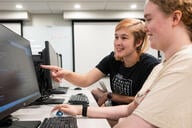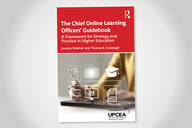You have /5 articles left.
Sign up for a free account or log in.
What do universities mean when they talk about “online education”? This is a question that Marc T. Austin, associate provost and dean of Augusta University Online, wanted to figure out. So, he did some quick research. This Q&A with Marc is about what he found.
Q: What was the research question you wanted to answer, and what made you want to answer it? How did you go about doing this research?
A: As Augusta University embarked on an ambitious new effort to establish an internal online program management model to support a suite of graduate programs in health, cyber and education under the banner of Augusta University Online, we encountered a tremendous array of AU online courses and programs already well underway.
Like many other universities, Augusta was forced to pursue an assortment of remote instructional approaches in response to the COVID-19 pandemic. As we began building Augusta University Online, we needed to define what we meant by “online,” not only for ourselves but also for our students.
I reached out to a handful of leaders in the field of online education that I have worked with over the years and asked how they defined “online” at their institutions.
I asked this question with the starting assumption that a fully online program should be, at a minimum, asynchronously accessible to students who do not live near campus and can access their courses at any time around their schedules. These students should not feel at risk of not completing their degree if the timing and location of the classes doesn’t align with their needs.
I used this fairly narrow starting point because of the audience we seek to initially engage: professionally focused graduate students, though we will eventually design our offerings for undergraduates.
I then asked the following: “When delivering a fully asynchronous online program (a full degree), have you permitted faculty to run ‘attendance-optional’ lectures in live, synchronous formats, but recorded for later student viewing?”
A critical difference in online versus on-ground instruction is the flexibility we can offer students. To model online courses after on-ground ones wouldn’t justify the need and innovation required. I had to ask myself, “Should we blend synchronous with our asynchronous focus?”
I really believe we have to think beyond the proverbial four walls, ensuring online students will not be penalized for missing synchronous sessions, thus offering “optional” attendance. This still provides faculty with the option for live synchronous learning and engagement opportunities, using tools such as videoconferencing technology. So, in theory, it offers the best of both worlds, but we needed to test that theory.
Q: What did you find out? Did any of your findings come as a surprise?
A: My sample was small (12 leaders responded)—some of the universities represented use external OPMs, others do not. I have paraphrased and edited their responses below, as I felt the commentary was as valuable as the overall groupings of responses.
The responses broke down into three categories that are perhaps best described in mixologist terms:
- Blended is best: This group of online leaders believes the mixed mode—asynchronous and synchronous—is best. You will see that even this solution comes with a few notes of caution, which brings us to the next category.
- Mix, with a dash of caution: Over all, this group felt that a mixed modality can work but is often not as valued by the student as they hoped and entails some significant operational challenge. So, adding in synchronous helps, but there are major risks to consider.
- Juice is not worth the squeeze: These are the “spirits purists.” The online learner is the online learner; there’s no need to mix the modes (and spoil a perfectly fine spirit). As long as the underlying asynchronous course is a good one, synchronous is a lot of effort and does not produce better results in terms of the learning experience.
My sense is that there are lessons from all three perspectives:
1. Blended is best.
Students like options: Students typically expressed satisfaction with a mix of asynchronous and synchronous course structure and appreciated the variety of options available to them to learn the content. I will say that the truly online student relied heavily on the recordings of these sessions but still liked having the option to attend.
Synchronous, but chat: We use optional synchronous chats offered three times throughout the semester on different days/times. These optional chats offer deeper discussions on a topic, so if students don’t have the time to engage at that level, they don’t miss anything they need for the course by not attending.
Recordings work if they are incentivized: We have used asynchronous lectures in response to specific student questions and offer students feedback (via podcast and video). When we create incentives for watching and listening (i.e., extra-credit opportunities), participation increases. There is a percentage of students who don’t take advantage of these additional opportunities, and the difference in their work was noticeable.
Blended is here to stay: Some of our faculty use this approach in their online courses. In essence, they use live lectures/discussions with interaction, but attendance is not required. We generally see strong turnout for the live class components, and this approach gives students the flexibility to attend to other commitments and watch the lecture later, highlighting that the mix of asynchronous and synchronous is here to stay.
2. Mix, with a dash of caution.
Synchronous is best, but! We don’t run any fully asynchronous online programs. We have two hybrid degree programs that require low-residency participation where the online part is a mix of asynchronous and synchronous teaching. Classes are limited to 25 students, who can opt for the online asynchronous version and/or join or listen to the recorded/live lecture. For the most part, students love it and want the live interaction. This means that for some programs, we have had to list the times of the live sessions at the time of registration, which means faculty have to commit in advance. This has made adjunct recruitment a bit more complicated.
Synchronous required: Real-time synchronous sessions are required at our university. They are also recorded, and an instructor may allow a student who missed classes to view it, but not as an open policy. Nonetheless, optional real-time sessions need to be offered on a variety of days and times since students taking a 100 percent asynchronous course may want to attend synchronously and have scheduling challenges (e.g., time zones, jobs, other classes, family care).
Synchronous, but with control: We define an online program as an approved body of courses, delivered through the university’s online learning management system, that can be completed free of specified times and locations. In general, we like to see synchronous activities focused on supporting substantive coaching, feedback or synthesis around class objectives. So, we allow up to 20 percent of a program’s credit hours to be delivered through synchronous interactive video conferencing or similar technologies. This approach to online learning enhances the flexibility faculty desire while respecting the needs of online students to be able to adapt time and location. Students do appreciate opportunities to interact, but also appear most satisfied when they are in control of when they elect to participate in a synchronous session.
Synchronous, yes, but take care with the recordings: My faculty are free to do whatever they feel will support student learning within the confines of what the delivery model dictates (i.e., 100 percent asynchronous really means no required real-time sessions). The challenge with recorded synchronous sessions is the length of the recording and interruptions or distractions. What happens when you have recorded a session that has “gone off on a tangent”?
3. The juice isn’t worth the squeeze
When given a choice, only a handful participate: Students who want to participate in synchronous come, and those who don’t participate tend to not watch the recordings, either. Generally, only a handful participate in the synchronous offerings, so the value is questionable.
Required synchronous can damage enrollment: Programs that require online students to attend live sessions have negatively impacted their enrollments.
Optional synchronous—if only they had listened! We have tried blending optional synchronous with asynchronous a few times in various classes because the faculty was really thinking it would be a value add. We warned them about the reasons not to try this approach, and they discovered:
- No one will attend (seriously). Even with the best-laid plans, maybe a couple students show up. And when they do, they come in at various times, and it requires the faculty to repeat themselves.
- You can’t introduce new content in optional live sessions, as it is optional. What is the point of an optional live lecture if it’s not new information?
- When you record these optional sessions, you will need to do editing work, like closed captioning, to ensure it’s accessible.
- We stored the recordings and no one watched them, so ultimately, the faculty always ended up stopping the live sessions.
What I do recommend, if the faculty or instructor is open to it, is offering synchronous appointments that a student can make with them—like on-demand office hours—because even physical office hours at a set time tend to have low to no attendance on any given week.
A burden for faculty—I have not tried blending synchronous options with asynchronous courses to date. The obstacle for our faculty is just finding the additional time to have an optional lecture, as our course loads are heavy. Students say that they will attend, but then they never show.
Q: From what you discovered, what do you think are the main take-home messages that academic and online university leaders should be internalizing? What should we be doing or thinking differently?
A: As with all research questions, the answer to my question about asynchronous versus synchronous is “it depends.”
But the question helped me with our process. At Augusta, we have opted to offer fully asynchronous degrees (to be advertised and conveyed to students as such) but we left room for experimentation, allowing our central team to approve the use of synchronous supplements where it makes sense.
I was surprised to not see any discussion from the group about the importance of seeking student permission to share synchronous recordings in the LMS given FERPA considerations, but a few participants in my poll pinged me later about this. It is easy enough to ensure student permissions at the start of a class that includes live synchronous recordings, but in the end, I was caught somewhere in the middle of this debate. Asynchronous learning is necessary to promise a student a fully online accessible degree that meets both location and scheduling needs that the online focused learner has. Yet we also recognize the value of the connections and coaching created by live meetings.
Here are six takeaways from our process that others may wish to consider:
- Have an explicit policy to clarify expectations for both students and faculty about the mode of online instruction.
- Don’t advertise or detail the modality to students until you are sure it will work for all parties.
- Take the time to write down the approach and keep it centralized and available. (At Augusta, we have built an internal policy intranet site for our staff and faculty.)
- Don’t create standards that just make life difficult, but ensure that when the word “online” is used, it evokes a sense of a high-quality, fully-supported student experience, not an imperfect copy of an otherwise excellent face-to-face experience.
- Communicate about online learning. Our intranet, announcements, newsletters and articles drive home the message that there’s a new standard in town.
- Monitor instructional quality. It’s easier to monitor quality in the online space except when it’s synchronous and not recorded. It is important to remember that the ability to ensure quality depends on your ability to assess it over time; so, regardless of the modes chosen, consider how you can continuously improve.
As with all studies, it’s important to add the caveat of what the researcher would have done differently in the research. In this case, it’s obvious: include the views of the online learners, not just the academic administrators that are reflected here.
For Augusta University Online, we need a few more years to have our own students provide feedback and join focus groups; however, for many universities with robust online programs, it might be a good time to test this question with student cohorts. For instance, if you have a cohort that is fully online already, ask them whether they value optional synchronous lectures or prefer fully asynchronous learning.
We are still early in our efforts, and I expect there will be quite a few lessons to learn in the next two to three years; so, my colleagues should be on the lookout for my next informal pulse poll.




